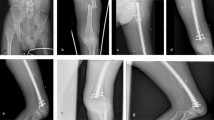Abstract
Background and purpose
As patients who were afflicted with poliomyelitis during the outbreaks in the past are aging, lower extremity osteoporotic fractures are becoming more frequent. Fixation in deformed, porotic bone, coupled with muscle weakness and imbalance creates a unique challenge when treating these fractures as does their reduced rehabilitation potential. The aim of this study was to investigate the outcome of femoral fractures in surviving poliomyelitis patients.
Patients and methods
Sixty-five patients with 74 femoral fractures were treated between 1990 and 2014. Clinical outcome was assessed using the Parkland and Palmer mobility score, and quality-of-life was assessed using the SF-12® score.
Results
Some 84% of the fractures were a result of low-energy mechanisms and occurred in the polio-affected limbs, but nonaffected limbs were also injured owing to low-energy mechanisms in all cases. Fifty-seven fractures were treated operatively. There were nine re-operations (16%), including implant removals, nonunion, peri-implant fractures, and malunion. Some 60% of the patients did not regain their previous ambulatory capacity. Post-operative weight-bearing status did not correlate with the final functional outcome.
Conclusions
Polio patients with femoral fractures have a guarded prognosis for regaining their pre-injury ambulatory capacity. A higher re-operation rate than that with “normal” osteoporotic fractures is expected.



Similar content being viewed by others
References
Mohammad AF, Khan KA, Galvin L, Hardiman O, O’Connell PG (2009) High incidence of osteoporosis and fractures in an aging post-polio population. Eur Neurol 62:369–374. https://doi.org/10.1159/000242444
Nam KY, Lee S, Yang EJ, Kim K, Jung S, Jang SH, Han SN, Kim WH, Lim JY (2016) Falls in Korean polio survivors: incidence, consequences, and risk factors. J Korean Med Sci 31:301–309. https://doi.org/10.3346/jkms.2016.31.2.301
Cummings S, Melton L (2002) Epidemiology and outcomes of osteoporotic fractures. Lancet 359:1761–1767. https://doi.org/10.1016/s0140-6736(02)08657-9
Konda S, Pean C, Goch A, Fields A, Egol K (2015) Comparison of short-term outcomes of geriatric distal femur and femoral neck fractures. Geriatr Orthop Surg Rehabil 6:311–315. https://doi.org/10.1177/2151458515608225
Lau J, Parker J, Hsu L, Leong J (1986) Paralytic hip instability in poliomyelitis. J Bone Joint Surg (Br) 68-B:528–533. https://doi.org/10.1302/0301-620x.68b4.3733824
Chang J, Fan J, Lam H, Cheung K, Chu V, Fung K (2009) Treatment of an osteoporotic Hoffa fracture. Knee Surg Sports Traumatol Arthrosc 18:784–786. https://doi.org/10.1007/s00167-009-0960-4
El-Sayed Khalil A (2010) Locked plating for femoral fractures in polio patients. Arch Orthop Trauma Surg 130:1299–1304. https://doi.org/10.1007/s00402-010-1126-z
Wang W, Shi H, Chen D, Chen Y, Wang J, Wang S, Qiu Y, Xiong J (2013) Distal femoral fractures in post-poliomyelitis patients treated with locking compression plates. Orthop Surg 5:118–123. https://doi.org/10.1111/os.12035
Vaquero J, Munoz J, Prat S, Ramirez C, Aguado H, Moreno E, Perez M (2012) Proximal femoral nail antirotation versus Gamma3 nail for intramedullary nailing of unstable trochanteric fractures. A randomised comparative study. Injury 43:S47–S54. https://doi.org/10.1016/s0020-1383(13)70179-7
Lee D, Jo J, Jung J, Kim S (2014) Prognostic factors predicting early recovery of pre-fracture functional mobility in elderly patients with hip fracture. Ann Rehabil Med 38:827–835. https://doi.org/10.5535/arm.2014.38.6.827
Leland N, Gozalo P, Christian T, Bynum J, Mor V, Wetle T, Teno J (2015) An examination of the first 30 days after patients are discharged to the community from hip fracture postacute care. Med Care 53:879–887. https://doi.org/10.1097/mlr.0000000000000419
Author information
Authors and Affiliations
Contributions
YNG and YAW designed the study, supported data collection, performed data analyses, and wrote and revised the manuscript. AK, ML, and RM designed the study, operated the patients, and critically reviewed the manuscript.
Corresponding author
Ethics declarations
Conflict of interest
The authors declare that they have no conflict of interest.
Ethical approval
An IRB (institutional Review Board) approval was obtained for this study according to the 1964 Helsinki Declaration.
Additional information
Publisher’s Note
Springer Nature remains neutral with regard to jurisdictional claims in published maps and institutional affiliations.
Rights and permissions
About this article
Cite this article
Gellman, Y.N., Khoury, A., Liebergall, M. et al. Outcome of femoral fractures in poliomyelitis patients. International Orthopaedics (SICOT) 43, 2607–2612 (2019). https://doi.org/10.1007/s00264-019-04285-2
Received:
Accepted:
Published:
Issue Date:
DOI: https://doi.org/10.1007/s00264-019-04285-2




